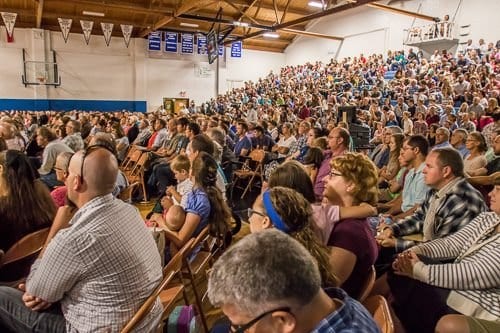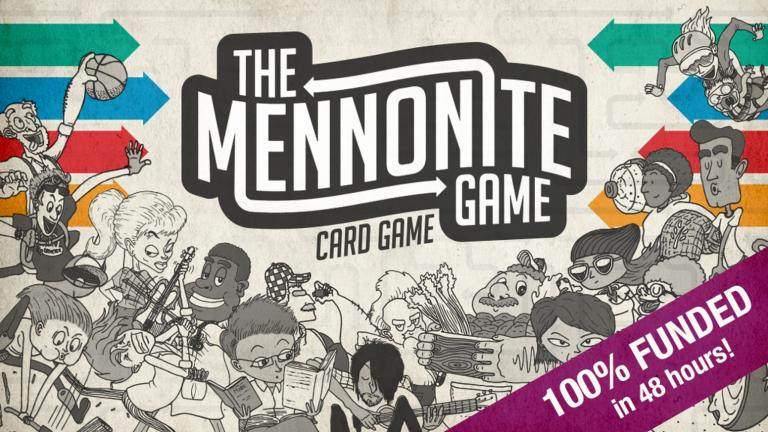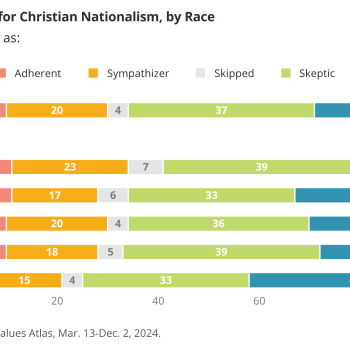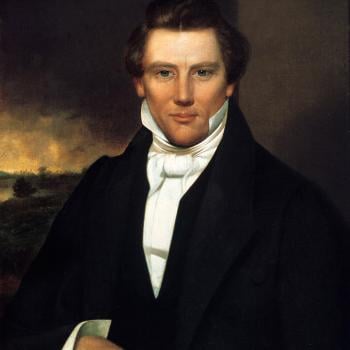In the small conservative Mennonite denomination I grew up in, we played a game. It was called the “Mennonite Game,” a version of the Kevin Bacon “six degrees of separation” party game. The goal was to see how quickly two Mennonites, meeting each other for the first time, could establish common family connections and church links.

Once a year 2,000 people would flood a small Midwestern town (it rotated between Arthur, Illinois; Goshen, Indiana; Sugarcreek, Ohio; Kalona, Iowa; Rosedale, Ohio; Hartville, Ohio; and Greenwood, Delaware) for a weekend gathering. Between sermons, basketball, and white bread rolls under a big green tent, we would test the boundaries of our tight network. I was the son, grandson, and great-grandson, and great-great grandson of a dozen prominent ministers and bishops, and so I had lots of material to work with.
The Game would begin like this: What is your mother’s maiden name? [Miller] What was your great-great grandmother’s maiden name? [Yoder] Where do you live? [central Ohio] Did your parents meet at Rosedale Bible Institute? [Yes] Do you have an Aunt Sarah who was a missionary to Costa Rica? [No] Did your Great-Grandpa Ivan J. Miller marry us in 1948? [I have no idea.]
I pretended that the Game was annoying, but I secretly liked it (though not as much as this lady). As a consummate insider, as a privileged son with the right last name and bloodlines in a patriarchal religious group, I felt grounded in history and enjoyed the warm bonds of close community.
As I grew older, I began to sense the limits of the Game. I abruptly stopped playing if one of the few Hispanic Mennonites in our group walked by. I knew they couldn’t play the Game as fully I could, and I didn’t want them to feel excluded. To be sure, connections came through institutional, not just ethnic, forms, but these connections were difficult for new arrivals to cultivate in a group where ethnicity and churchly institutions overlapped so thickly.
Indeed, my close community was largely a closed community. Our relative isolation from society and our tendency to marry other Swiss-German Mennonites meant that last names like Johnson, Gutierrez, or Nguyen did not appear often in our group. More than once I heard (and sometimes thought myself), “That’s not a Mennonite name.” It seemed difficult to integrate first- and second-generation Mennonites into our tight community.
A recent study has born that out. Statistically speaking, I was very unlikely to marry someone who was nonwhite. Not long ago, several scholars used Census Bureau data to analyze the surnames of 270 million Americans to determine those most likely to be held by certain races or ethnicities. Check out their findings:
White
Yoder 98.1
Krueger 97.1
Muller 97.0
Koch 96.9
Schwartz 96.8
Schmitt 96.8
Novak 96.8
Schneider 96.7
Schroeder 96.7
Haas 96.7
A person with the surname of Yoder, one held by many of my ancestors, has a 98.1 percent chance of being white. A person with the last name of Muller, which is a variant of my mother’s maiden name, has a 97.0 percent chance of being white. A person with the last name of Schwartz, a variant of my own surname, has a 96.8 percent chance of being white. Put it all together, and I may have been the least likely white person to marry someone of a different race. As it turned out, I married a Russian-German Mennonite, but even the Russian part was really German. Her ancestors were actually German farmers invited by Catherine the Great to modernize Russian agriculture and farm the rich steppes of Ukraine.
To be sure, other religious groups cultivate close ethnic communities. As the following charts show, the percentages of certain Asian and Hispanic surnames rival those of “whites.”
Hispanic
Barajas 96.0
Orozco 95.1
Zavala 95.1
Velazquez 94.9
Ibarra 94.7
Juarez 94.7
Black
Washington 89.9
Jefferson 75.2
Booker 65.6
Banks 54.2
Jackson 53.0
Mosley 52.8
Dorsey 51.8
Gaines 50.3
Rivers 50.2
Joseph 48.8
Asian
Zhang 98.2
Huang 96.5
Choi 96.5
Li 96.4
Huynh 96.2
Yu 96.2
Nguyen 95.9
Pham 95.9
Wu 95.9
Tran 95.6
So “white” German Mennonites aren’t the only ones with tight ethnic connections, but they do suffer from a particularly sordid history. In Chosen Nation: Mennonites and Germany in a Global Era, Ben Goossen shows how Mennonites in World War II willingly submitted to Nazi “racial biologists,” who wanted their extensive genealogical records and lauded them as “ideal specimens of humanity.” On the Eastern Front, Mennonites who had remained in genetically pure communities were delighted when Nazis liberated them from Bolshevik rule. They happily underwent racial testing in order to return to the West and resettle farms taken from Poles and Jews. SS documents cited Mennonites as “the outstanding example” of avoiding integration with their impure surroundings. Goossen found one ancestor list with an image of a swastika rising from the sea, illuminating a brighter dawn. It turned out, writes Goossen, that these Russian Mennonites, who continued to speak German and marry only other German Mennonites, were “more Aryan than the average German.” Some of these Mennonites left Germany after the war and carried this very strong German identity to Canada, the United States, and Mexico.
Though streaks of ethnonationalism remain in some sectors of American Mennonitism, times are changing. People of color now comprise the majority of the nearly 1.2 million members of the global Mennonite family. According to The Mennonite, the largest and fastest-growing Mennonite church in the U.S. is an African-American congregation in Hampton, Virginia, Calvary Community Church. Nearly 20 percent of Mennonites in the United States are Hispanic, African-American, Native American, or Asian. The growth of Anabaptism across the globe has implications for Mennonites and Anabaptists whose fading numbers in North America are bolstered by the rise of the Congolese and Ethiopian churches.
All this is beginning to militate against the kind of ethnic exclusivity that the Mennonite Game sometimes engenders. Which is a good thing for a couple of reasons. Biologically, more genetic diversity may prevent the proliferation of bipolar disorder within populations that share a lot of common ancestors. Anabaptist victims of persecution and resettlement have been especially vulnerable to population bottlenecks that perpetuate a particular genetic code. Theologically, the broadening of Anabaptist ethnicity honors its Reformational past, when faith in Jesus Christ, not loyalty to an ethnicity or a state, qualified a person to be a disciple in good standing with the church.
So does the Mennonite Game, which recently became the subject of an academic article, a hit four-part harmony Youtube song, and an actual card game, inevitably turn belonging into exclusion? Does it implicate Mennonite systems of white privilege? Does celebrating ethnic relationships, as Goossen suggests, “mean having something in common with Nazi race scientists”? Like German-Russian Mennonites who took land from murdered Jews, German Mennonites in the Americas “settled” the land of many indigenous peoples. In northern Indiana and southern Michigan, Mennonites displaced the Potawatamie. In Iowa, Mennonites displaced the Sauk and Mesquakie. In Kansas Mennonites displaced the Kanza. In Mississippi, efforts at “evangelization by colonization” in the 1950s displaced jobs and land held by African Americans.
 I don’t exactly know how to reckon with these historical examples of exclusion. Part of me thinks that we could play a version of the Mennonite Game that emphasizes institutional connections and theological resonances over family relations. Indeed, I’ve been grafted into and extended my own networks at Asbury University where I teach and where I regularly meet people affiliated with United Methodism, Free Methodism, and the Salvation Army who seem more Anabaptist than my hundreds of second cousins who go by Yoder, Weaver, Beachy, and Hochstetler. That said, history and family matter. In the end, can institutional ties bind as tightly as those from childhood? Can water be thicker than blood? Is it helpful to be cosmopolitan if you’re not rooted in anything?
I don’t exactly know how to reckon with these historical examples of exclusion. Part of me thinks that we could play a version of the Mennonite Game that emphasizes institutional connections and theological resonances over family relations. Indeed, I’ve been grafted into and extended my own networks at Asbury University where I teach and where I regularly meet people affiliated with United Methodism, Free Methodism, and the Salvation Army who seem more Anabaptist than my hundreds of second cousins who go by Yoder, Weaver, Beachy, and Hochstetler. That said, history and family matter. In the end, can institutional ties bind as tightly as those from childhood? Can water be thicker than blood? Is it helpful to be cosmopolitan if you’re not rooted in anything?
What does seem clear is that the Mennonite Game reveals an inherent tension between belonging and exclusion. It’s a tension that should be considered deeply as we seek to stave off isolation in this age of loneliness.
















